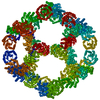+Search query
-Structure paper
| Title | Intranasal SARS-CoV-2 RBD decorated nanoparticle vaccine enhances viral clearance in the Syrian hamster model. |
|---|---|
| Journal, issue, pages | bioRxiv, Year 2022 |
| Publish date | Oct 27, 2022 |
 Authors Authors | D R Patel / A M Minns / D G Sim / C J Field / A E Kerr / T Heinly / E H Luley / R M Rossi / C Bator / I M Moustafa / S L Hafenstein / S E Lindner / T C Sutton /  |
| PubMed Abstract | Multiple vaccines have been developed and licensed for SARS-CoV-2. While these vaccines reduce disease severity, they do not prevent infection, and SARS-CoV-2 continues to spread and evolve. To ...Multiple vaccines have been developed and licensed for SARS-CoV-2. While these vaccines reduce disease severity, they do not prevent infection, and SARS-CoV-2 continues to spread and evolve. To prevent infection and limit transmission, vaccines must be developed that induce immunity in the respiratory tract. Therefore, we performed proof-of-principle vaccination studies with an intranasal nanoparticle vaccine against SARS-CoV-2. The vaccine candidate consisted of the self-assembling 60-subunit I3-01 protein scaffold covalently decorated with the SARS-CoV-2 receptor binding domain (RBD) using the SpyCatcher-SpyTag system. We verified the intended antigen display features by reconstructing the I3-01 scaffold to 3.4A using cryo-EM, and then demonstrated that the scaffold was highly saturated when grafted with RBD. Using this RBD-grafted SpyCage scaffold (RBD+SpyCage), we performed two unadjuvanted intranasal vaccination studies in the "gold-standard" preclinical Syrian hamster model. Hamsters received two vaccinations 28 days apart, and were then challenged 28 days post-boost with SARS-CoV-2. The initial study focused on assessing the immunogenicity of RBD+SpyCage, which indicated that vaccination of hamsters induced a non-neutralizing antibody response that enhanced viral clearance but did not prevent infection. In an expanded study, we demonstrated that covalent bonding of RBD to the scaffold was required to induce an antibody response. Consistent with the initial study, animals vaccinated with RBD+SpyCage more rapidly cleared SARS-CoV-2 from both the upper and lower respiratory tract. These findings demonstrate the intranasal SpyCage vaccine platform can induce protection against SARS-CoV-2 and, with additional modifications to improve immunogenicity, is a versatile platform for the development of intranasal vaccines targeting respiratory pathogens. |
 External links External links |  bioRxiv / bioRxiv /  PubMed:36324809 / PubMed:36324809 /  PubMed Central PubMed Central |
| Methods | EM (single particle) |
| Resolution | 3.4 Å |
| Structure data | EMDB-27812, PDB-8e01: |
| Source |
|
 Keywords Keywords |  PROTEIN BINDING / nano-cage / PROTEIN BINDING / nano-cage /  self-assembly / self-assembly /  fusion protein fusion protein |
 Movie
Movie Controller
Controller Structure viewers
Structure viewers About Yorodumi Papers
About Yorodumi Papers







